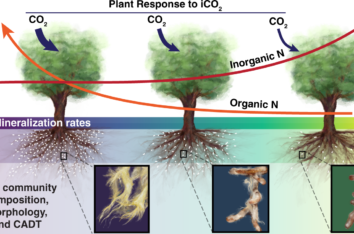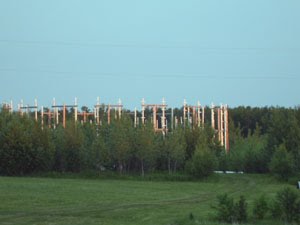Collaborators
Kurt S. Pregitzer, Andrew Burton & Erik Lilliskov, School of Forest Resources & Environmental Science, Michigan Technological University, Houghton, Michigan 49931
Abstract
Nitrogen (N) saturation of terrestrial ecosystems is one of the most important contemporary ecological issues. Researchers at Michigan Technological University and the University of Michigan initiated a long-term, replicated (3 replicate plots x 2 treatments: N-amended and control, 4 study sites) field experiment in 1994. The purpose of this field experiment is to understand the mechanisms controlling carbon (C) and N cycling in the face of chronic N deposition and the long-term consequences of N saturation. Moderate levels of N addition (30 kg NO3–N ha-1 y-1 for seven years) have quickly caused advanced stages of N saturation to occur in this very common northern hardwood ecosystem that spans an entire biome in the Great Lakes region of the USA.
In this project, a series of hypotheses are aimed at elucidating the mechanisms and consequences of altered ecosystem metabolism. Specifically, increased N availability is hypothesized to induce an “enzymatic latch”, which decreases decomposition and enhances C storage in the soil. It is predicted that nitrate (NO3-), dissolved organic carbon (DOC) and dissolved organic nitrogen (DON) will continue to leach from these ecosystems, as they have done thus far in response to the NO3- deposition treatment. These forests may eventually become totally N saturated, with leaching outputs that equal simulated atmospheric inputs. A series of alternative hypotheses is also presented to test the theoretical predictions concerning the mechanisms regulating C and N cycling in this ecologically and economically important Great Lakes ecosystem. The study is one of few long-term experiments world-wide where predictions regarding long-term responses to N deposition, and the mechanisms controlling them, can be tested in the field, strengthening the scientific community’s ability to predict real-world ecosystem responses to global change. The experimental approach encompasses molecular analyses of microbial community composition and function as well as measurements of the ecosystem-level fluxes of C and N through these northern hardwood ecosystems. It represents a unique opportunity to integrate across levels of ecological organization to understand ecosystem-level processes and responses.



